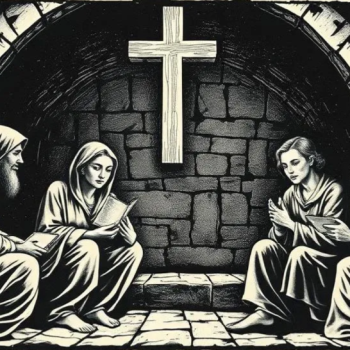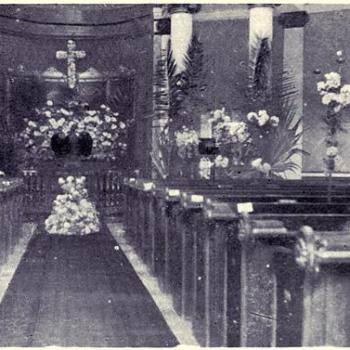 Ever since I received my First Holy Communion as a little girl, I have had a great love for the Blessed Sacrament.
Ever since I received my First Holy Communion as a little girl, I have had a great love for the Blessed Sacrament.
I know that some wonderful, good friends in the Church have expressed doubts about the true presence of Christ—body, blood, soul, and divinity—in the Eucharist, and I too have prayed, "Lord I believe, help me in my unbelief."
The Eucharist does, after all, have the appearance and taste of bread and wine.
Reflecting on these facts a few weeks ago, I had a "God moment" while waiting to receive, and thought: What if I was going up to receive a small piece of human flesh—heart tissue and human blood with its distinctive salty taste?
Wow, that was a sobering thought! It made me stop to realize that, taste and texture aside, this was precisely what I was about to do. I approached to receive Communion feeling struck with a renewed awe, and back in our pew I became emotional as I prayed in this revelation: I just taken into my body the actual flesh, and blood of our Savior! What a humbling thought. As a friend of mine once said, "Is my tongue worthy to hold his body?"
Jesus often taught in parables, but he also spoke in literal terms about truth. In chapter 6 of the Gospel of John, Jesus says that his flesh is true food and his blood is true drink (Jn. 6:51-58). This teaching was one of his most important, but also one of the most difficult for his followers to comprehend. They said, "This saying is hard; who can accept it?" The word Jesus used for eat was the word, "to chew" or "gnaw." It sounded to them like cannibalism. And drinking his blood? This was strictly forbidden in Leviticus; it was too much!
Many walked away. What is interesting is that Jesus—who always clarified his meaning when his apostles didn't "get" his words—did not try to soften it. He did not say, "Hey, come on back and let me explain what I really mean."
Jesus was certainly speaking literally, and not being "politically correct," or making things comfortable for his followers. Instead of backing off from his bold words, he said to the twelve, "Do you also want to leave?" Simon Peter answered Him, "Master to whom shall we go, you have the words of eternal life. We have come to believe, and are convinced that you are the Holy one of God" (Jn. 6:67-69). I'm sure that Peter, and the others were baffled and didn't understand what Jesus meant any more than the others did, but they trusted him, nevertheless. Their understanding was not immediate; it came after Jesus' death and resurrection, and the coming of the Holy Spirit at Pentecost.
Jesus said what He meant, and meant what He said. Transubstantiation is not too difficult for the God of Creation.
Enter the words "Lanciano, Italy" and "Eucharistic Miracle" into a search engine, and you will read a true story about a miracle the church has studied and called "worthy of belief." In about 700 A.D., a monk, celebrating in the Greek Rite and using leavened bread, had doubts about the True Presence of Christ in the Holy Eucharist. When he said the words of consecration the bread and wine turned into human flesh, and blood in his hands. This miracle can still be seen today—the flesh has not decayed. The blood has coagulated into five pieces of different sizes, which correspond with the five wounds of Jesus on the Cross.
In 1971, scientific studies were conducted on these relics by Dr. Odoardo Linoli. He concluded that the flesh is real flesh, and the blood is real blood; both flesh and blood belong to the human species; the flesh consists of the muscular tissue of the heart complete in its essential structure. Both flesh and blood have the same blood type—AB positive.
AB positive is the "universal recipient" of blood types. In John 12:32 Jesus did say, "And when I am lifted up from the earth, I will draw everyone to myself." He was lifted up on the cross. He draws everyone to himself, in the blood.
I think of all of this when I receive Holy Communion, and when Ed and I attend Eucharistic Adoration. Adoration is something we have committed to doing each week.
Because I can't see the Monstrance with the Host, my experience is different. Every day is busy and hectic when we arrive at church, but when we open the doors of the chapel and I smell the faint scent of incense, I immediately feel the True Presence of the Lord there. It is not something I can explain, but I know that Jesus is really there, physically Present, not just spiritually, and I can "feel" his Presence in an almost tangible way.
I have been asked, "Can't you just pray anywhere? Isn't God everywhere?" Yes, of course, but Adoration is a special experience. As soon as we go into the chapel I feel a peace come over me, no matter how distracted I felt before. It is quiet, and I feel like I am completely alone with Him, that there isn't anyone else there, even though I know perfectly well that Ed and others are with me. We privately worship, pray, adore, and just sit with him, letting the Lord speak to our hearts, and he does. As Jesus asked the apostles to do in the Garden of Gethsemane, we remain with him.
To know Ed is sitting next to me while we are each spending intimate time alone with God, both together in worship, is a special blessing that has truly enriched our marriage.
If we trust that all things are possible with God, why then is this so hard to understand or believe?
1/28/2011 5:00:00 AM





